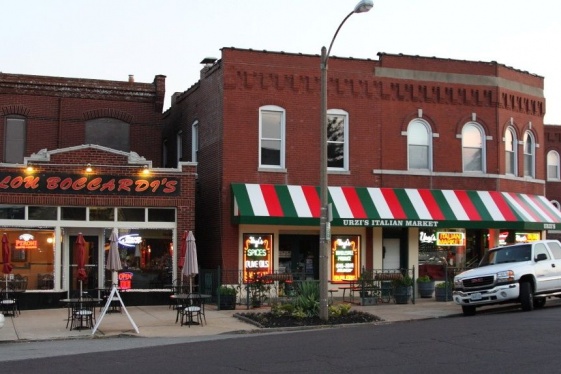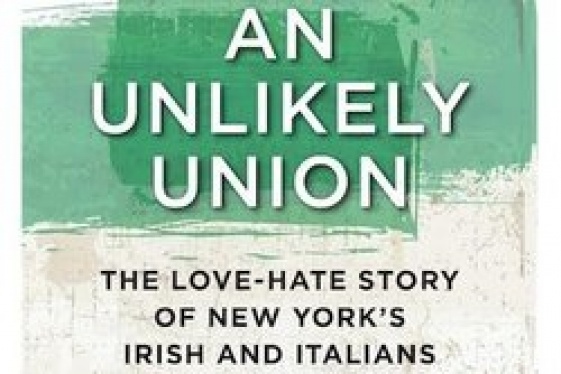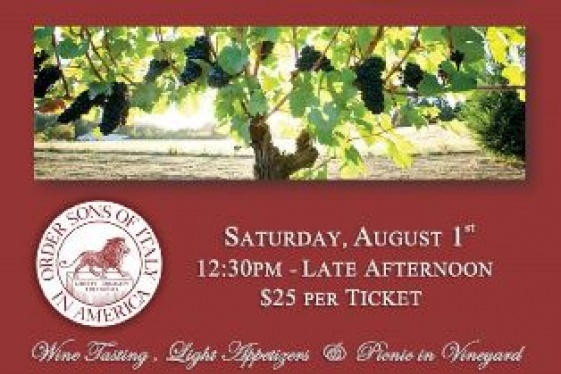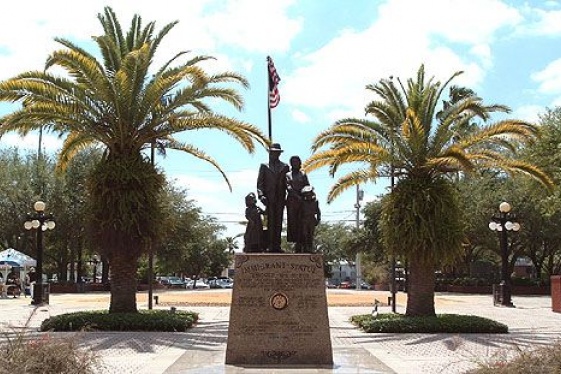
Sticks and Stones: Does “Gioglio” Mean “Plumber?” A Genealogical Tale

BY: Gerald R. Gioglio
A Name is a Name is a Name
We sat around a table in Moscow’s bar located across street from the playground of my youth, Feaster’s Park in New Brunswick, NJ. It was just us, the men in the family; well, two men, one boy; the adults were Lenny the plumber and Len, Jr. the cop, a New Brunswick Police Officer. We were, as they say, “‘shootin’ the breeze” on a lazy summer afternoon in the late 1950s.
Somehow the conversation shifted to our Sicilian last name, Gioglio. Both the old man and the cop agreed that they did not know anybody, anywhere with that surname, except for a couple of relations in Morristown, NJ—a small city where the family settled after leaving Brooklyn, NY. They assumed there must still be a Gioglio or two in “the Old Country,” but settled on “who knows?”
The men each had a ‘schooner’ of beer; the kid a schooner of 7-Up. As a piece of glassware the schooner was a peculiarly masculine accoutrement. Crystal clear, it looked like a supersized wine glass with an immense bowl that probably held 1-2 pints of beer. The bowl sat on top of a thick, tapered stem and a sturdy base. Much more than a glass or a mug, schooners were for getting serious about one’s drinking. When a man asked for a schooner it was like a kid saying, “I’ll take a large, please.”
These first and second generation Italian-Americans also did not know about the Sicilian passion for pistachios; one that dates back to antiquity. We loved them too, didn’t question why, and certainly had no idea that it might have something to do with our heritage; “in the genes” as one might say. At Moscow’s the old man would always dig a bunch of nickels out of his pocket. These were to be deposited in the solitary vending machine stationed at the end of the bar—usually next to the guy with the thousand-yard stare who clearly had one too many schooners that day.
You put in a nickel, turned the knob and got a fist full of pistachio nuts, salted, in red-tinted shells. In the 1950s kids didn’t have coloring placemats to amuse them. The nuts were a tastier challenge. To get at the meat you cracked the shell either with teeth or fingernails, often no small feat. Since there were no women at the table one was not burdened with warnings about breaking a tooth or getting the dirt out from under fingernails before assaulting those shells. Hey, like the schooner, this was a man thing.
At one point in the conversation the kid posed the question, “So, what does our last name mean, dad?” “You know, like people named for what they do, ‘Cooper’ for barrel maker or ‘Smith’ for blacksmith? “Does ‘Gioglio’ mean ‘Plumber’?” The adults were more than amused, yet clearly befuddled and agreed there was no answer to this question either. Besides, we were Americans, stuff like that did not make a difference, so who cares.
Sticks and Stones
They did agree on this: here, in America, the name Gioglio should be pronounced “Joe-Leo.” (This, of course, turned out to be a gross mispronunciation of the original Sicilian) Anyway, America--“Joe-Leo.” Does it get any easier than that? Well…given all those vowels and ‘g’s obviously not. The pronunciation problem was universal. It was the rare when someone said “Joe-Leo” on the first try.
Here is a partial list of typical, well-meaning, but flawed attempts to pronounce that name: Jill-e-o, Jew-jill-e-oh, Gee-ju-leo, Gu-leo, Gog-leo, Gee-o-gee-lo. There was also Gee-og-lee-o and Giglio, the latter a real Italian name (both close, but no cigar.) One of my favorites was ’jelly-roll’….a mean-girl version laid on a sister. The most troublesome, given its connotation, was the disreputable ‘gigolo’. This one was always delivered with a smirk by men or with raised or fluttering eye lids from women. It was hard to be patient and to gently correct that appellation without falling into the trap. It didn’t matter much in childhood—who knew? But in adulthood, if suggested by men, one could be tempted to lose one’s commitment to nonviolence, or if offered by women to flatter oneself with the thought, ‘in your dreams sweetheart.’ Thankfully, a quick, knowing laugh and a cool head always prevailed.
Anyway, the name issue got shelved for a few decades. Then, as if by wizardry, the Internet appeared. With it came the ability to seek out and contact others both in America and abroad concerning this troublesome surname. It turns out there is a Gioglio clan in Ohio—who actually have Gioglio reunions in Middle-America; others were located in Italy and Sicily. Clues, correspondence, documents, poems and citations, some stretching back hundreds of years soon followed.
Names Will Never Hurt Me…
The first clue about the meaning of the name involved the aforementioned and much more prevalent Italian surname ‘Giglio.’ Said to mean, ‘Lily;’ it is also the name of an island off the coast of Italy. Then there was the word, ‘giaggiolo’ meaning ‘Iris.’ These references to flora suggested that the ‘Gioglio’ surname might have something to do with some sort of plant-life.
And indeed that proved to be so. A book by Andrea Garbocci & Ferdinando Cazzuola dated 1888 provided both a picture and a description of the gioglio plant. It suggested that there are two different types of gioglio, both carrying the same name. Depicted on the left side of the image is, “Lolium Italicum” (Italian Cockle or Darnel). The more spiked portion of the plant, on the right, is called “Lolium Temulentum.” (‘Drunken cockle’). Whaat!!!???
According to the authors “Lolium Italicum”:
…”commonly known as Giogliarello or Gioglio (‘is one of the best forage plants, very much sought after for cattle feeding’).”
On the other hand:
“Lolium Temulentum [is] commonly known as Gioglio or Lollio. [A] weed that grows in both wheat and rye fields, it is injurious to human health, if eaten in a rather big quantity it can cause convulsions and delirium.” Hmm…
So we have Lolium/Lollio/Gioglio (more correctly “Gee-o-yo” in the Sicilian); given the timbre and similarity, one can easily speculate that the Gioglio name morphed over the centuries from these original Latin roots.
From contact made with another Gioglio living in Piedmont, Italy, we learn that the word had disappeared from Italian dictionaries; the last reference found being the Zingarelli Dictionary of the 1953. Again, there was reference to positive and negative properties. The dictionary reference roughly translated as:
"gioglio. weedy grasses, cockle,” and;
"cockle, a kind of a grass …important to the annual planting, spontaneous between the harvests, …has poisonous properties …bad gioglio." Hmm…
More and more, other old and sometimes ancient references appeared on the Internet connecting the Latin words lolium and lollio with gioglio.
In 1819, Edward Dodwell published Classical and Topographical Tour through Greece. Referring to Lolium, he reports, “It is the Darnel, Cockle or Ray of the English, the Gioglio of the Italians, and the Ivraie of the French.” He footnotes a line in the Eclogues written in 37 BCE by the ancient poet Virgil who ponders a field where, “there but wild oats and barren darnel spring”.
Jumping ahead to 1902 we find a reference in a sonnet, Alcyone by Gabriele D’Annunzio. The relevant section roughly translated as:
Praised is the spike in the afternoon!
She tilts to the Sun that cooks it,
toward the earth damp grass was born;
she tilts and more she will tilt tomorrow
toward the earth where it will be more collapsed
with the gioglio his wicked brother.
Dark and mysterious; but what exactly did D’Annunzio have in mind when pondering this ‘wicked’ brother of the wheat? After all, ‘wicked’ has many meanings, that is, something likely to cause harm or distress or, and here’s the rub, something mischievous. Hmm…
Finally, an 1841 elementary school text by Luigi Granata also suggests two forms of the plant exist; one a perennial plant with “flowers and seeds.” He talks about its cultivation and proclaims “it is not fully in fruit until after one year” and that it is harvested “just like oats.” The second form is again referred to as a “harmful plant” and an “annual,” but he provides no other details. Apparently, as chaff, the ‘bad’ gioglio grew among the wheat, oats and rye and depending on the perspective of the writer, could have differing effects on people if ingested.
Pane de Gioglio!
Going back further to 1586, Castore Durante mentions “Il Pane di Gioglio” (Gioglio bread!) in his book, Il Tesoro Della Sanita (The Treasure of Health). Here things get a bit dicey; roughly translated he writes, “gioglio bread makes the head hurt and effects vision”. [This is] “why Italian women select [from] the wheat with great care and diligence to feed the chickens.”
But wait a minute. Ok, the women are separating out the bad gioglio, and not feeding it to the chickens, but they are making bread out of it –for what? To give the men in their lives a headache, or for some other, clever and beneficial reason?
From an 1812 publication titled, Dramatic Poems Rusticali, edited by Giulio Ferrario we find a play, “The Marriage of Maca, Commedia Rusticale” by Francesco Mariani. Here the word gioglio is cited in Act III Scenes 1 and 9. In Scene 1 we find a difficult to translate reference that seems to describe wheat and gioglio as ‘black bread.’ In Scene 9; we find a character, Arrecarsi, who “mangier il pan del gioglio,” roughly, “eats the gioglio bread.’ More importantly, Giulio’s book includes a Glossary of Terms; here we are told that,
pan fatto di farina di gioglio o loglio reca sonnolenza, onde mangier il pan del Gioglio vale calmarsi acquietarsi.
This 19th Century Italian roughly translates to:
gioglio bread made of flour or chaff [causes] drowsiness, so eat gioglio bread to calm down, [to] settle down.
“To calm or settle down”? That sounds therapeutic…not bad at all!
What’s in a Name?
Taken together, the gioglio plants are a Greek mask—good and, shall we suggest, somewhat naughty. The happy side of the mask is a crop that can be harvested for feed. The naughty side of the mask is the ‘bad Gioglio,’ the ‘drunken cockle. ’ But again, perhaps not so dark, for it appears if prepared correctly, the bread can soothe and calm one down, make you drowsy (or, dare we suggest in modern parlance) get you high? Perhaps it is mildly similar to ‘ergot’ discovered among the rye in France, or the “Alice B. Toklas” cannabis brownies of America.
At this point we get a sense that the perennial gioglio plant was a cash crop harvested and used for cattle and poultry feed; that is, gioglio growers cultivated, farmed, used and sold it. Meanwhile, farming women found ways to incorporate the wheat with the annual gioglio chaff to bake bread to help soothe our savage beasts.
In his article Sicilian Surnames – History and Onomatology, Luigi Mendola says, “The great majority of hereditary Sicilian surnames were assumed during the fifteenth century. We know that the names of plants are often reflected in Sicilian names, for example, ‘Cipolla’ (onion grower) or ‘Palmieri’ (palm grower). So there you have it. For now, we can speculate that at some unknown point in time, probably somewhere between the fifteenth and seventeenth century, ‘Gioglio’ (grower of darnel and/or baker of pacifying bread) was adopted as the farming or share-cropper family’s surname.
Happy news indeed, and if they were still with us, the plumber and the cop would have been tickled to death to learn this and to know that other folks carrying our mischievous surname still walk the planet. One wonders if there is somebody out there who still bakes that bread. If you find such a baker do not be afraid to say, “I’ll take a large please.” A nice, thick slice of this soothing concoction just might go well with a schooner of beer.
You may be interested
-
“The Hill” St. Louis’ Little Italy
When the fire hydrants begin to look like Italian flags with green, red and white stripes,...
-
A wreath for Columbus and three crowns for t...
The Columbus Day Committee of Atlantic City along with the Bonnie Blue Foundation annually...
-
An Unlikely Union: The love-hate story of Ne...
Award-winning author and Brooklynite Paul Moses is back with a historic yet dazzling sto...
-
Polisena delivers address as state lawmakers...
"Italian-Americans came to our country, and state, poor and proud," Johnston Mayor Joseph...
-
Sons of Italy Wine Tasting Series
Saturday, August 1 - 12.30 EDT / Valenzano Winery - 1090 Route 206, Shamong, New...
-
The “Little Italies” of Michigan
In doing reseach for this post, I was sure that Italian immigrants found their way to Detr...
-
Ybor City – Florida’s Little Italy
"The people who had lived for centuries in Sicilian villages perched on hilltops for prote...
-
''La Gente di Mulberry Street'' presentato a...
Valsinni- Italia, terra di emigranti. Presentato a Valsinni il nuovo saggio storico di Raf...










